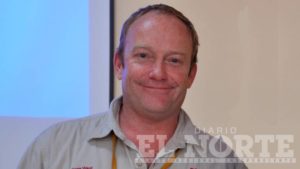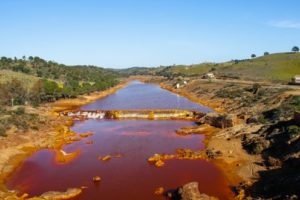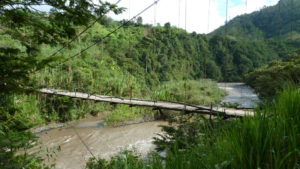CAN ENSA CEO JASON WARD REALLY BE AN ENVIRONMENTALIST?

The Cascabel concession is part of the Mira River basin, and is surrounded by mature primary and secondary forests that house endangered species, and protect pristine microbasins. Our primary concerns with mining in Cascabel hinge on the ecosystem impacts of the mine itself and related infrastructure, as well as the toxic waste generated by mining activities.
SolGold itself says says that it will extract 2.4 billion tonnes of ore from the mine. Based on that figure, MRAG estimates the tailings generated by this mine would amount to at least 1km3 (1,000,000,000 m3). To put these figures in perspective, the capacity of Laguna Quilotoa is 0.35km3, making a conservative estimate of tailings produced enough to fill Laguna Quilotoa three times over.
This is a phenomenal amount of toxic waste to dispose of that no amount of “green talk” by Mr Ward can hide away.

Tailings vary but may contain or produce cyanide, radiation, alkalinity (high pH) or acidity (low pH), arsenic, high salinity in pore water (pore water is in the spaces between particles of sand, rock or tailings). They can also produce sulphides which creates acid that dissolves any heavy metals in the tailings, like mercury, lead or arsenic into a liquid can be washed away into rivers or streams. Toxic gases may be released due to chemicals within the tailings. Some tailings remain highly contaminated for at least 1000 years. Some facilities may need a longer time to be considered safe.
In their preliminary reports, SolGold states that decisions regarding the management of tailings are still in preparation. Can Jason Ward guarantee that the mined rocks do not contain pyrites or monosulphides, and can he guarantee that SolGold/ENSA will maintain tailings dams in the Cascabel concession for hundreds of years to ensure the toxicity of this waste is safely contained?
Given that the mine is in an area of high rainfall and earthquake risk, can Mr Ward guarantee that the structure of tailings dams built on the Cascabel concession will be sound and will not be vulnerable to earthquakes, overflow from heavy rain or increased waste volumes, as occurred with the Vale/BHP disaster in Bento Rodrigues in November 2015, or that of Brumadihno, where 300 Brazilians died when the tailings pool collapsed in January 2019? We understand that SolGold has a limited experience in the construction of mines - to date it has not built a single mine. The approval of a record-height tailings dam at Mirador leaves us highly concerned that similar foolhardy constructions will be approved at Cascabel.

Given the entire Cascabel concession is part of the catchment for the Mira River which then runs through Colombia, contaminants that put this river system at risk could cause an international incident. Additionally, it is probable that contaminants would affect the thousands of users who live downstream of the mine, including municipalities that depend on the river to provide drinking water to their citizens, farmers, ranchers, aquaculturists, among others. Will all downstream communities and users who rely on the Mira River be consulted and compensated in the event of a disaster?
If tailings dams are not built, the other recourse for waste disposal is to dump mine waste into waterways. This is the case at the Ok Tedi mine in Papua New Guinea where 80 million tons of contaminated tailings and materials from mine-related erosion are dumped each year into the Ok Tedi river system after the tailings dam collapsed in 1984. Established by Australian mining company BHP Billiton, the terrain of the Ok Tedi mine is similar to that of Cascabel.
The river is now effectively unable to sustain life, affecting the lives of 50,000 people who relied on the river for fishing and drinking water. They have experienced numerous health issues, including high rates of cancer and birth defects. More than 1,588 square kilometres of forest died as a result of the disaster. Given Solgold's limited experience with mining in places with such high rainfall, can Mr. Ward ensure that this will not happen in Cascabel?
Can the Ecuadorian state even guarantee that it will have the economic resources and human capital – and political will – to regulate and control the mining of this magnitude, in view of the numerous and proven irregularities reported by the Comptroller General of the State in this same project, as in the case of the Llurimagua mining project?
Our organisation is concerned that Alpala – ENSA/SolGold’s main area of interest – will not be the only mine constructed in the Cascabel concession. From SolGold’s reports, we are given to understand that there are several other ore bodies that ENSA/SolGold are exploring within the concession. Is Mr Ward able to disclose if this is the case, and if these ore bodies will be block cave mined individually, or absorbed into one large supermine several kilometres in size?
SolGold touts block cave mining as a more environmentally friendly option. However, it could be argued that block caving is virtually no different from an open cut mine as the mine falls in on itself after resources are extracted. Block sinking mines are also notoriously complex to build.
As Australians, we can see the incredible beauty of Ecuador’s natural resources, and we feel ashamed that Australian mining companies are exploiting local people’s needs for jobs, health and education, in an exchange that will leave Ecuadorians dealing with the environmental consequences of mining for hundreds of years to come.
El Norte published our concerns in an article here.
